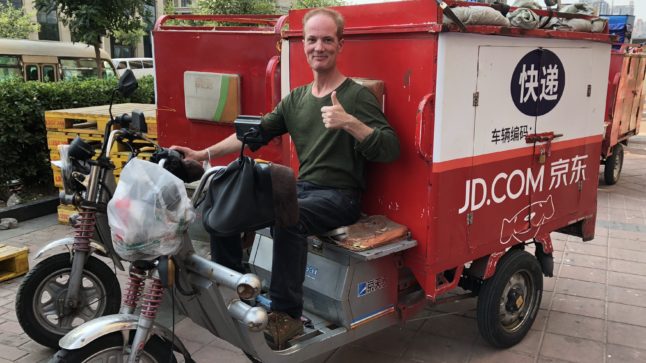I keep a short list of cool stuff China’s digital giants are doing. Not just the big initiatives – but the smaller and often more inventive ideas. And JD tends to have a lot of these. From building their own robotics and drones to trash sorting / redemption programs and farming initiatives, JD has lots of stuff moving all the time.
In the next couple articles, I’ll detail 3 things JD is doing that I think are particularly cool. And first on the list is whether they can bring Moneyball and digital marketplaces to small Chinese farms.
First, why do value investors love Moneyball so much?
For those not familiar with the term, Moneyball was the title of a Michael Lewis book and later a Brad Pitt movie. And it has become a go-to book for understanding many of the concepts of value investing (used by Warren Buffett, Mario Gabelli, Seth Klarman, etc.). It is also about introducing data-driven decision making into a traditional business.
The book is about Billy Beane, the executive vice president of the Oakland A’s baseball team. It is about how, starting in 1997, he took one of the poorest teams in baseball and completely changed how it bought its baseball players. He jettisoned the traditional approaches, such as listening to scout and looking at a player’s speed, youth, and “swing”. He instituted a data-driven approach and began hunting for cheaper players that were mispriced. He began buying players the same way value investor buy stocks, based on measured value. Hence, the term moneyball.
For example, he ignored popular players who were already successful – and who were therefore expensive. And he hunted among players others didn’t want – and who were therefore cheap. He signed older players, who were undervalued due to bias against age. He signed players who looked funny when they threw the ball. He signed injured players. His data-driven approach let him see value others could not. He assembled an island of misfit toys that was cheap – and that his data showed were actually very good.
The end result (spoiler alert) is in 2002, the A’s became the first team in 100+ years of American League baseball to win 20 consecutive games. And he did it with a team that cost like 1/10th of what was normally paid. And in the process, he changed how baseballs teams were run.
So it’s a story about value investing (not totally relevant here). But it’s also a story about replacing traditional, intuitive and experience-based practices with data-driven approaches. And so now people frequently talk about doing Moneyball in industries. Is so-and-so company doing Moneyball in retail? Is so-and-so doing Moneyball in construction? And so on.
It’s a great book. I was sent a copy by Columbia Business School as summer reading prior to enrollment. And I have taught it in my investing class at PKU for like 9 years. Plus, my father used to be the dentist for the Oakland A’s, so I have lots of memories of meeting their players as a kid. Funny, how things come around in life.
Anyways, I think JD is basically doing Moneyball for small Chinese farms.
Small Chinese farms have lots of big problems
Farming and agriculture are some of China’s biggest challenges. Everyone always points to the lack of oil reserves and affordable housing as the big national issues. But if you want to get the government’s attention fast, talk agriculture and water. If food price inflation increases or if there is a pork shortage (like now), the government flies into action.
I am not an agriculture expert but some of the commonly cited reasons for this are:
- There is not much arable land in China. China has about 7% of the world’s arable land but 22% of its population.
- There is also very little water. China is a particularly dry country and much of the water is polluted and/or used for industrial.
- The population is huge which means lots of demand for food and water (both to drink and to grow crops and livestock).
- The population is getting wealthier which means they are eating more and more expensive and resource-requiring foods. They are eating less rice and more steak (which requires a lot more water and grain).
- There is a legacy of having lots of small farms and villages. Note: when China opened to the world in 1980, about 80% of the population was still living in rural areas (compared to say 20% in the US and Japan). And even today, this sector still has many of the older ways.
So you frequently hear about tech giants (Legend Holding, Yunfeng Capital) focusing on agriculture tech. And there is tons of effort going into modernizing farming, increasing productivity / yields and generally “doing more with less”. And the huge numbers of small farms are part of this. Keep in mind, China is only about 65% urbanized today, which means you still have about 500M people living in the countryside.
Enter JD Farms, which is working on giving data technology and tools to small farms. And one of the great things about digital technology is that it has a very low threshold for adoption. You don’t have to be in a developed economy or located in a city to get its benefits.
JD’s Farm Initiatives
I got a brief rundown on a conference call with Zhiwei Qiao, Head of JD Farms – and the basic idea is to start to apply various digital tools and marketplace connectivity to smaller farms. And this is really what digital platforms and tools do best – to empower SMEs. To address their pain points. And to bring them onto digital marketplaces.
- For consumers, the biggest issue with produce today is an increasing demand for safe and better-quality food.
- For farmers, the biggest issue is how to maximize yields off small pieces of land. How to not overuse fertilizer and water. Plus other issues like pest control and monitoring.
JD is targeting these issues – and has 17 farms in various stages of collaboration with the company.
- They are providing digital tools like IoT (sensors for measuring fertilizer and water usage and needs), blockchain (for tracking and logistics), and AI (to analyze the data). This is about digitizing the business and making it data-driven (i.e., Moneyball for farms).
- They have also published 14 JD farm standards. These have been developed with multiple universities and should give farmers a playbook for their processes. Farms can also get certifications from JD for safety and standards.
Those first two are really about Moneyball for farms. The farms will start to abandon traditional, passed-down methods (like dumping on the fertilizer) for more data-driven approaches and standards.
But JD is doing some other important stuff with farms.
- They are giving them access to the JD marketplace so they can sell directly.
- They are offering support services like their nationwide logistics / delivery network and their payment / finance services.
To me, that looks like four big things for farmers:
- A big increase in sales reach. Suddenly small farms can sell to the whole country.
- An ability to go to market themselves. Bypassing the distributors will reduce costs.
- Lots of data and tools for improving their processes. Big farms have this. It’s the small farms that don’t.
- Greater efficiency. The small farms get higher yields by tracking how much fertilizer and water is needed.
These are early stages, but it looks compelling. JD says a peach farm in Shandong and a pear farm in Hebei were able to increase their prices by 30-50% as a result.
From Moneyball to Digital Marketplaces
A common approach for digital platforms is “come for the app, stay for the platform”. You offer tools that address pain points (the above Moneyball points). And then the SMEs end up joining a platform long-term.
In How Did Alibaba Beat Everyone, I had an introduction to digital platforms (and network effects) and why they are so important. But there are a lot of details. And we will increasingly go into the different types of platforms and their strengths and weaknesses. Some questions to keep in mind for marketplace platforms are:
- Is the marketplace local, regional, or international?
- Are they exchanging physical goods, digital goods, differentiated services or non-differentiated services?
- Are the enterprises fragmented vs. consolidated?
- Are the enterprises differentiated or non-differentiated?
Some example:
- JD and Alibaba are both selling mostly physical goods nationally (mostly. And the merchants are fragmented with some differentiation (L’Oréal, Apple). However, a lot of the merchants are non-differentiated (cables, toilet paper).
- Didi is a marketplace for non-differentiated services (a ride across town). It is mostly a local (rides in Beijing). And the enterprise side is fragmented (lots of individual drivers).
- Meituan is a marketplace for differentiated services (Sushi vs. hotpot vs. burger restaurants). It is mostly local and fragmented (lots of small restaurants).
- Ctrip is an international marketplace for flight reservations, which are non-differentiated services in a consolidated market (only 10-15 airlines). But the hotel bookings are differentiated services in a fragmented and regional or international market. Ctrip offers a lot more value in hotel reservations, which is why they are always pushing you to book a hotel with your fight.
In theory, a digital marketplace should make great sense for small farms. Agriculture is physical products with high fragmentation and a national market. The degree of non-differentiation could be a problem, but some farms should be able to build differentiated brands based on quality, safety and other factors. It will probably be a mix, just like with other physical goods.
That’s it. Overall, I think it’s pretty cool.
In the next article, I’m going to talks JD’s trash recycling and redemption program. And some of their IoT logistics initiatives.
Cheers and thanks for subscribing,
Jeff
———
I write, speak and consult about how to win (and not lose) in digital strategy and transformation.
I am the founder of TechMoat Consulting, a boutique consulting firm that helps retailers, brands, and technology companies exploit digital change to grow faster, innovate better and build digital moats. Get in touch here.
My book series Moats and Marathons is one-of-a-kind framework for building and measuring competitive advantages in digital businesses.
Note: This content (articles, podcasts, website info) is not investment advice. The information and opinions from me and any guests may be incorrect. The numbers and information may be wrong. The views expressed may no longer be relevant or accurate. Investing is risky. Do your own research.

